Yeovil people
William Welch
Agricultural & Veterinary Chemist, Wine Dealer & Grocer
William Welch was born in 1827 at Sixpenny Handley, Dorset, and baptised at the neighbouring village of Gussage St Michael on 29 October 1827. He was the seventh of the eight children of yeoman Stephen Welch (1773-1852) and his wife Anne (1787-1850). Stephen and Anne's children were; Anne (1812-1887), Charles (1814-1892), James (1819-1833), Jane (b1821), John (b1821), Stephen (1825-1895), William and Henry Robert (1832-1919).
In the 1841 census, 13-year-old William was recorded as a boarding student at the Stalbridge Academy, Stalbridge, Dorset. The 1851 census recorded William as an assistant to chemist William Phillipson and was living above the shop premises in North Street, Chichester, Sussex, with Phillipson and his family. Within a year or two, William had moved to Yeovil and opened his own chemist's shop in High Street. He took over the business of chemist Edward Granger who had just retired.
Now established with his own business, on 30 April 1855 William married Annie Caines (1831-1916) at St James' church, Chilton Cantelo. Annie was the eldest daughter of Mr John Caines of Chilton Cantelo. William and Annie had five children, all born in Yeovil; Annie Kate (b1856), Henry Ewer (b1859), Emma Jane (b1861), John Milton (1866-1916) and Edith Constance, known as Edie, (b1872). As a sidenote, William and Annie's son John Milton Welch was probably the oldest Yeovil soldier killed in the Great War.
The 1861 census recorded William and Annie, together with their children Annie and Henry, as well as two assistants and a domestic servant. It appears that William had (temporarily) changed occupation since was recorded as a 'Wine & Spirit Merchant & Grocer'.
In the 1871 census, William and Annie were living above the shop in High Street with their children: Henry, Emma and five-year old John. Also living above the shop were a chemist's assistant and a general servant. William now refined his occupation in the census as 'Chemist & Wine Merchant'. The advertisement below (see Gallery) from 1875 noted that he was an 'Agricultural and Veterinary Chemist' and, as most chemists of his day, concocted a wide range of cure-all remedies.
By the time of the 1881 census, William had moved his family to a house in Kingston, immediately next door to the Red Lion Hotel (see Gallery) where he would remain for the rest of his life. Living with him were Annie and their two young children, John and Edie. William gave his occupation as a wine and spirit merchant. The following 1891 census listed William and Annie with Emma and Edith. William, now aged 65, gave his occupation as 'Commission Agent, formerly Druggist'. Both Emma and Edith were listed as teachers of English. The 1901 census was almost identical, although William gave his occupation as a chemist and the two daughters were both recorded as governesses, working from home.
In the 1911 census of 39 Kingston, 83-year-old William and 79-year-old Annie were listed with their three children; John, Emma and Edith. By this time William and Annie had been married for 55 years and four of their five children survived into adulthood. William gave his occupation as 'Chemist (Retired), and of the children, all of whom remained unmarried, 45-year-old John worked as a clerk for the Conservative Association and Emma and Edith, aged 49 and 38 respectively, remained as governesses.
William died in Yeovil on 31 October 1912. He was 85. Annie died on 31 May 1916, also at the age of 85. Both died at home, at 39 Kingston.
Map
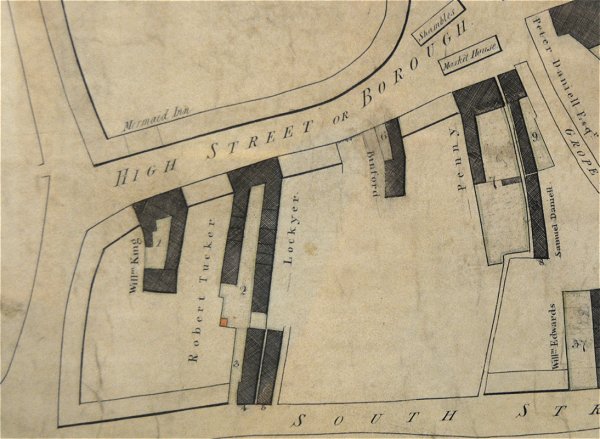
A section of John Martin's 1813 map of the properties owned by the Yeovil Corporation (shown blacked-in). The property William leased was that blacked-in property shown at farthest left, opposite the Mermaid Inn.
gallery

The record of William's baptism from the Gussage St Michael parish register.
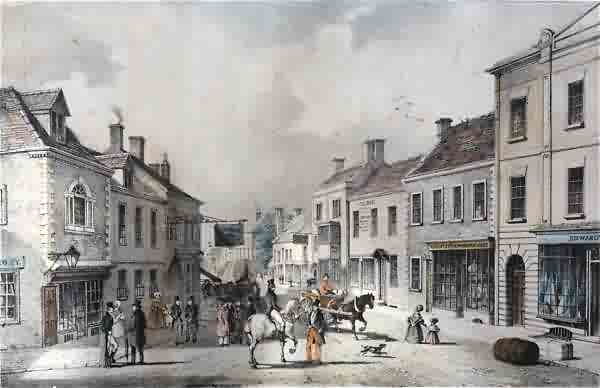
From my
collection
This lithograph looks down High Street from its junction with Hendford / Princes Street. On the left the Mermaid with its familiar archway and large overhanging sign is clearly seen. On the opposite side of the road, just right of centre, the white three storey building with the two-storey projecting bay is the Kings Head Inn. It is likely that the two storey building next to the Kings Head Inn is the building that held the former George Inn.
This hand-tinted stone lithograph was by Henry Burn (1807-1884) entitled 'Market Place - Yeovil'. There are not many known stone lithographs by Henry Burn because he left for Australia in 1852. It was published by William Porter and Henry Marsh Custard in January 1839 and printed by Charles Joseph Hullmandel (1789-1850) of London, where he maintained a lithographic establishment on Great Marlborough Street from about 1819 until his death.
At extreme right the three-storey building just glimpsed is the newly-built premises of the draper's business, Edwards & Dean, later of draper Lindsay Denner (later still Beale's store). Next to it, the former Fleur de Lys, with a re-styled large shop window, is the Corporation-owned premises which by this time were occupied by Edward Granger, Chemist and Druggist and later occupied by William Welch.
For a more detailed account of the buildings in this 1839 lithograph, click here.
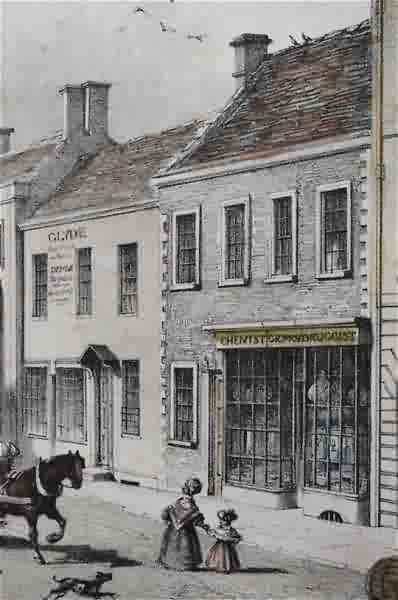
From my
collection
Enlarged from the lithograph above, the building at right, a property belonging to the Corporation, was the chemist and druggist premises of William Welch from the 1850s and the large glass vessels that were the distinctive sign of his trade are clearly seen in the shop windows. Both before and after this lithograph, this building was the Fleur-de-Lys, today it survives (albeit altered) as part of the late Beales' store.

The announcement
of William and
Annie's marriage
in the
Salisbury &
Winchester
Journal's
5 May 1855
edition.

An advertisement that ran weekly for a couple of years, first placed by William in the 26 January 1864 edition of the Western Flying Post. Eighteen gallons of ale for one guinea or a dozen bottles of sherry for £1 4s 0d - bargain!
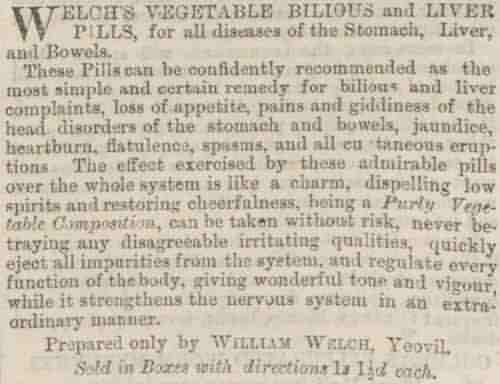
Another long-running advertisement in the Western Flying Post from October 1864, this advertisement shows that William hadn't completely given up his chemist's role.
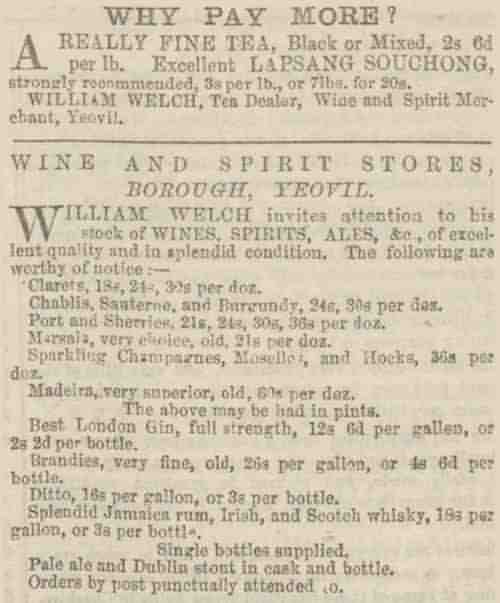
From 1865, William also listed himself as a tea dealer, as well as a wine & sprit merchant.
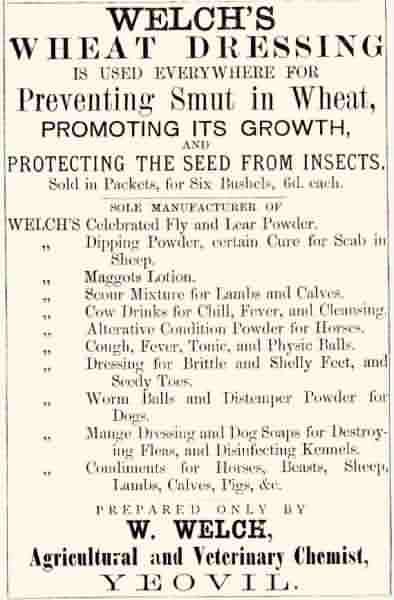
An 1875 advertisement by William Welch specifying the large range of agricultural and veterinary remedies he prepared. (One is tempted to ponder on the efficacy of such remedies).
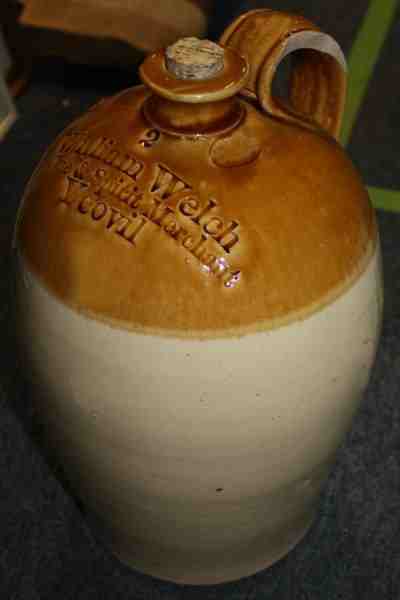
A 15-inch flagon used by William Welch in his Wine & Spirit Merchant guise.
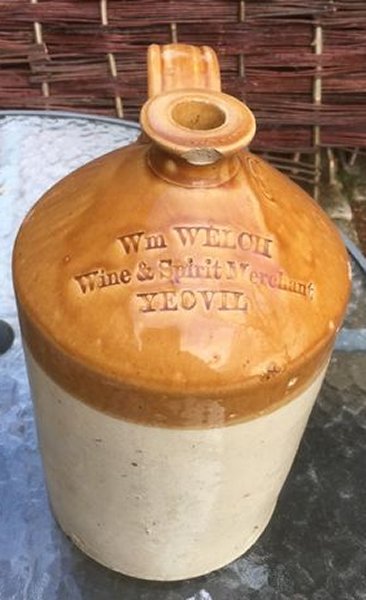
A differently-shaped flagon, also used by William Welch in his Wine & Spirit Merchant guise.
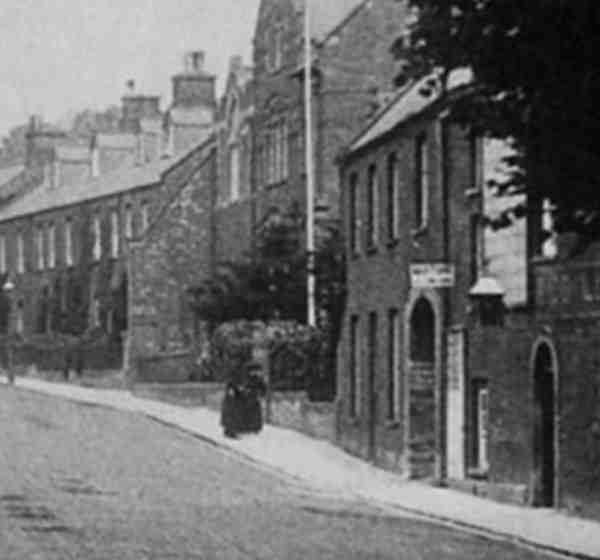
This
photograph
features in my
book "Lost Yeovil"
Looking along Kingston, towards Fiveways, the Red Lion Inn is seen at the extreme right, partly hidden by the tree, in this photograph taken around 1905. Between the tall archway and the flagpole of the County School was William Welch's house.
![]()
The notice of William's death in the Bournemouth Guardian's edition of 9 November 1912.
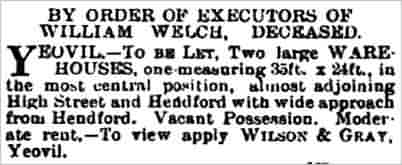
After William's death, his two warehouses were let. This notice is from the 6 December 1912 edition of the Western Chronicle.